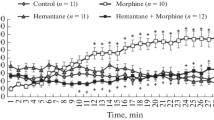Abstract
Acute treatment of rats either by high doses of morphine or Δ9-tetrahydrocannabinol (THC) decreased locomotor activity. Naloxone reversed morphine-induced depression completely and reversed THC-induced depression only partially. On day 3 of treatment, tolerance developed to the locomotor inhibitory action of THC or morphine and partial cross-tolerance was observed to the depressant action of THC. Naloxone slightly depressed locomotor activity in THC-tolerant rats, but increased motor activity in morphine-tolerant rats.
Similar content being viewed by others
References
Anderson PF, Jackson DM, Chesher GB, Malor R (1975) Tolerance to the effects of Δ9-tetrahydrocannabinol in mice on intestinal motility, temperature and locomotor activity. Psychopharmacologia 43:31–36
Bhargava HN (1976) Inhibition of naloxone-induced withdrawal in morphine dependent mice by 359-2. Eur J Pharmacol 36:259–262
Dewey WM, Johnson KM, Bloom AS (1976) Interactions of active constituents of marihuana with other drugs in the neuron. Ann NY Acad Sci 281:190–197
Gellert NF, Sparber GB (1977) A comparison of the effects of naloxone upon body weight loss and suppression of fixed-ratio operant behavior in morphine-dependent rats. J Pharmacol Exp Ther 201:44–54
Hine B, Friedman E, Torrelio M, Gershon S (1975a) Morphine-dependent rats: Blockade of precipitated abstinence by tetrahydrocannabinol. Science 187:433–445
Hine B, Torrelio M, Gershon S (1975b) Attenuation of precipitated abstinence in methadone-dependent rats by 359-3. Psychopharmacol Commun 1:275–284
Holtzman D, Bowell RA, Jaffe JH, Freedman DX (1969) 359-4: Neurochemical and behavioral effects in the mouse. Science 163:1464–1468
Holtzman SG (1974) Behavioral effect of separate and combined administration of naloxone and d-amphetamine. J Pharmacol Exp Ther 189:51–60
Jones RT, Benowitz N (1976a) The 30-day trip: Clinical studies of cannabis tolerance and dependence. In: Braude MC, Szara S (eds) The pharmacology of marihuana. Raven, New York, pp 627–642
Jones RT, Benowitz N, Bachman J (1976b) Clinical studies of cannabis tolerance and dependence. Ann NY Acad Sci 282:221–239
Kaymakcalan S, Deneau G (1972) Some pharmacological properties of synthetic Δ9-tetrahydrocannabinol. Acta Med Turo 9:19–23
Kaymakcalan S, Ayhan IH, Tulunay FC (1977) Naloxone-induced or post-withdrawal abstinence signs in Δ9-tetrahydrocannabinol-tolerant rats. Psychopharmacology 55:243–249
McMillan DE, Harris LE, Frankenheim JM, Kennedy JS (1970) 360-2 in pigeons: Tolerance to the behavioural effects. Science 169:501–503
Paton WDM, Pertwee RG (1972) Effects of cannabis and certai of its constituents on pentobarbitone sleeping time and phenazone metabolism. Br J Pharmacol 44:250–261
Peterson DW, Cohen GM, Sparber SB (1971) The delay of the effect of Δ9-tetrahydrocannabinol in rat by 2-diethylaminoethyl-2,2-diphenylvalerate HCl (SKF 525-A). Life Sci 10:131–138
Sofia DR, Vassar HB, Knobloch LC (1975) Comparative analgestic activity of various naturally occurring cannabinoids in mice and rats. Psychopharmacologia 40:285
Tulunay FC (1980) The effect of morphine and various narcotic antagonist-type analgesics on body temperature in rats. Life Sci 27:511–520
Tulunay FC, Uran B, Ayhan IH, Ülkü E, Kaymakcalan S (1980) Development of physical dependence in short-term tetrahydrocannabinol treated rats. Res Commun Subst Abuse 1:151–158
Tulunay FC, Ayhan IH, Portoghese PS, Takemori AE (1981) Antagonism by chlornaltrexamine of some effects of Δ9-tetrahydrocannabinol in rats. Eur J Pharmacol 70:219–224
Ülkü E, Ayhan IH, Tulunay FC, Uran B, Kaymakcalan S (1980) Effects of Δ9-tetrahydrocannabinol in rats on the morphine-induced hyperactivity of mice. Psychopharmacology 69:201–205
Uran B, Tulunay FC, Ayhan IH, Ülkü E, Kaymakcalan S (1980) Correlation between the dose and development of acute tolerance to the hypothermic effect of THC. Pharmacology 21:391–395
Wilson RS, May EL (1975) Analgesic properties of the tetrahydrocannabinols, their metabolites and analogs. J Med Chem 18:700–703
Author information
Authors and Affiliations
Rights and permissions
About this article
Cite this article
Tulunay, F.C., Ayhan, I.H. & Sparber, S.B. The effects of morphine and Δ-9-tetrahydrocannabinol on motor activity in rats. Psychopharmacology 78, 358–360 (1982). https://doi.org/10.1007/BF00433741
Received:
Accepted:
Issue Date:
DOI: https://doi.org/10.1007/BF00433741



